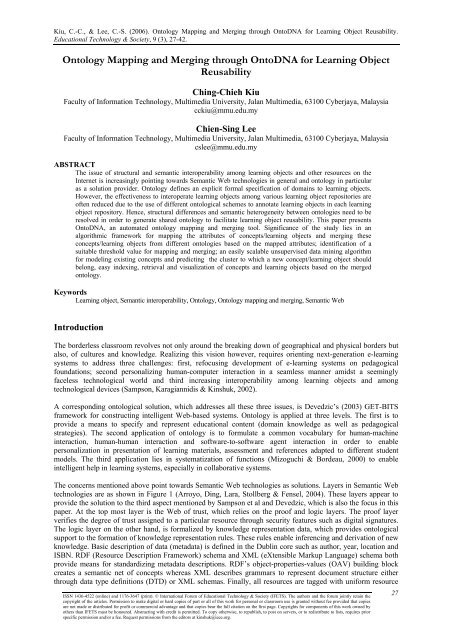July 2006 Volume 9 Number 3 - CiteSeerX
July 2006 Volume 9 Number 3 - CiteSeerX
July 2006 Volume 9 Number 3 - CiteSeerX
You also want an ePaper? Increase the reach of your titles
YUMPU automatically turns print PDFs into web optimized ePapers that Google loves.
Kiu, C.-C., & Lee, C.-S. (<strong>2006</strong>). Ontology Mapping and Merging through OntoDNA for Learning Object Reusability.<br />
Educational Technology & Society, 9 (3), 27-42.<br />
Ontology Mapping and Merging through OntoDNA for Learning Object<br />
Reusability<br />
Ching-Chieh Kiu<br />
Faculty of Information Technology, Multimedia University, Jalan Multimedia, 63100 Cyberjaya, Malaysia<br />
cckiu@mmu.edu.my<br />
Chien-Sing Lee<br />
Faculty of Information Technology, Multimedia University, Jalan Multimedia, 63100 Cyberjaya, Malaysia<br />
cslee@mmu.edu.my<br />
ABSTRACT<br />
The issue of structural and semantic interoperability among learning objects and other resources on the<br />
Internet is increasingly pointing towards Semantic Web technologies in general and ontology in particular<br />
as a solution provider. Ontology defines an explicit formal specification of domains to learning objects.<br />
However, the effectiveness to interoperate learning objects among various learning object repositories are<br />
often reduced due to the use of different ontological schemes to annotate learning objects in each learning<br />
object repository. Hence, structural differences and semantic heterogeneity between ontologies need to be<br />
resolved in order to generate shared ontology to facilitate learning object reusability. This paper presents<br />
OntoDNA, an automated ontology mapping and merging tool. Significance of the study lies in an<br />
algorithmic framework for mapping the attributes of concepts/learning objects and merging these<br />
concepts/learning objects from different ontologies based on the mapped attributes; identification of a<br />
suitable threshold value for mapping and merging; an easily scalable unsupervised data mining algorithm<br />
for modeling existing concepts and predicting the cluster to which a new concept/learning object should<br />
belong, easy indexing, retrieval and visualization of concepts and learning objects based on the merged<br />
ontology.<br />
Keywords<br />
Learning object, Semantic interoperability, Ontology, Ontology mapping and merging, Semantic Web<br />
Introduction<br />
The borderless classroom revolves not only around the breaking down of geographical and physical borders but<br />
also, of cultures and knowledge. Realizing this vision however, requires orienting next-generation e-learning<br />
systems to address three challenges: first, refocusing development of e-learning systems on pedagogical<br />
foundations; second personalizing human-computer interaction in a seamless manner amidst a seemingly<br />
faceless technological world and third increasing interoperability among learning objects and among<br />
technological devices (Sampson, Karagiannidis & Kinshuk, 2002).<br />
A corresponding ontological solution, which addresses all these three issues, is Devedzic’s (2003) GET-BITS<br />
framework for constructing intelligent Web-based systems. Ontology is applied at three levels. The first is to<br />
provide a means to specify and represent educational content (domain knowledge as well as pedagogical<br />
strategies). The second application of ontology is to formulate a common vocabulary for human-machine<br />
interaction, human-human interaction and software-to-software agent interaction in order to enable<br />
personalization in presentation of learning materials, assessment and references adapted to different student<br />
models. The third application lies in systematization of functions (Mizoguchi & Bordeau, 2000) to enable<br />
intelligent help in learning systems, especially in collaborative systems.<br />
The concerns mentioned above point towards Semantic Web technologies as solutions. Layers in Semantic Web<br />
technologies are as shown in Figure 1 (Arroyo, Ding, Lara, Stollberg & Fensel, 2004). These layers appear to<br />
provide the solution to the third aspect mentioned by Sampson et al and Devedzic, which is also the focus in this<br />
paper. At the top most layer is the Web of trust, which relies on the proof and logic layers. The proof layer<br />
verifies the degree of trust assigned to a particular resource through security features such as digital signatures.<br />
The logic layer on the other hand, is formalized by knowledge representation data, which provides ontological<br />
support to the formation of knowledge representation rules. These rules enable inferencing and derivation of new<br />
knowledge. Basic description of data (metadata) is defined in the Dublin core such as author, year, location and<br />
ISBN. RDF (Resource Description Framework) schema and XML (eXtensible Markup Language) schema both<br />
provide means for standardizing metadata descriptions. RDF’s object-properties-values (OAV) building block<br />
creates a semantic net of concepts whereas XML describes grammars to represent document structure either<br />
through data type definitions (DTD) or XML schemas. Finally, all resources are tagged with uniform resource<br />
ISSN 1436-4522 (online) and 1176-3647 (print). © International Forum of Educational Technology & Society (IFETS). The authors and the forum jointly retain the<br />
copyright of the articles. Permission to make digital or hard copies of part or all of this work for personal or classroom use is granted without fee provided that copies<br />
are not made or distributed for profit or commercial advantage and that copies bear the full citation on the first page. Copyrights for components of this work owned by<br />
others than IFETS must be honoured. Abstracting with credit is permitted. To copy otherwise, to republish, to post on servers, or to redistribute to lists, requires prior<br />
specific permission and/or a fee. Request permissions from the editors at kinshuk@ieee.org.<br />
27

















